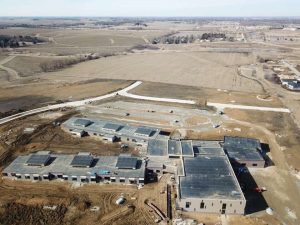03
Jul
Ninety Percent of Iowa Schools at Risk of Pesticide Drift

Ben Boezinger/Cedar Falls Tiger Hi-Line
Elementary school being built near farm fields.
(Beyond Pesticides, July 3, 2018) Nearly ninety percent of public schools in Iowa are at risk of toxic pesticide drift, according to a team of investigative reporters based at the University of Northern Iowa (UNI). A study conducted by Science in the Media, a UNI project, found that 9 out of 10 schools are located within 2,000 feet of an agricultural field, a proximity at which the risk of toxic pesticide exposure increases significantly. While the results have attracted the interest of lawmakers, media reports indicate legislative champions of this issue are having a difficult time gaining support for more protective measures.
According to the data gathered, 444,669 students and teachers are within close range of agricultural pesticide use. However, the reporters found public school employees generally unaware of the dangers or of any measures they could take. “As a teacher, I don’t know if there is anything sent out or part of any orientation to students or their parents, or anything like that,” said Louis Beck, an agriculture teacher at Union High School in La Porte City, IA to IowaWatch. “I have not been made aware of any protocol that we are supposed to have.”
Buffer zone laws and agricultural pesticide notification requirements are not widely adopted in U.S. states. However, the dangers posed by drift indicate that action is needed. A 2006 Iowa-based study published in Environmental Health Perspectives found that as proximity to agricultural fields increased, so did the likelihood that chemical pesticides would be found in one’s home. Even minute pesticide exposure can present significant risks to children’s health. Organophosphates such as chlorpyrifos, which Environmental Protection Agency administrator Scott Pruitt recently reversed the agency’s intent to ban, have been linked to attention problems, attention-deficit/hyperactivity disorder problems, and pervasive developmental disorders. This doesn’t just translate to difficulties for parents and teachers, but ultimately costs the economy in the form of lost brain power. A 2016 study published in The Lancet estimated that organophosphate pesticide exposure, resulted in 1.8 million lost IQ points, and 7.5 thousand intellectual disability cases annually at an estimated cost of $44.7 billion each year. Of that $44.7 billion, roughly $350 million in costs can be attributed to California, proportionately.
Despite the dangers, many Iowa legislators fell back on talking points used by the agrichemical industry. “It’s not a topic that has come up and it’s probably not a topic that I’m interested in today,” said Dan Zumbach (R-Ryan), the Iowa State Senate Ag Committee Chairman and a farm owner, in the Des Moines Register. I’m more interested in each property owner being responsible for themselves.”
However, IowaWatch interviewed State Senator David Johnson (I-Ocheyedan), who had a different take on the reasons for inaction. “Industrial agriculture has its grip on this legislature,” he said. “I’ve seen that before, and that generally stifles regulatory consideration when you have a legislature like it is now.”
Intensive farming states have been the slow to adopt buffer zone requirements around sensitive sites like schools, despite intense pressure from health and environmental justice groups. And when proposals are introduced, they are often watered down before final adoption. In California, rather than strengthen long-awaited rules to restrict pesticide use during school hours within ¼ mile of schools (to a whole mile), the CA Department of Pesticide Regulation weakened a requirement to notify schools 48 hours prior to an application. In Hawaii, after counties were preempted from imposing their own buffer zone rules, the fight moved to the state legislature. Following several years of work, state lawmakers declined to move forward with meaningful buffer zones, but instead opted to set the distance at 100 ft near public schools (however, to its credit the state legislature did become the first to ban neurotoxic chlorpyrifos).
Regarding farmers use of pesticides, Senator Rich Taylor (D- Mount Pleasant) noted in the Des Moines Register, “We can’t have them overspraying onto people living their normal life, whether it be school kids or citizens out enjoying the park. We’re going to have to look at this a lot more seriously.” Taylor has been considering a legislative proposal on the issue.
Beyond the creation of buffer zones around pesticide use is the point that dowsing fields with hazardous agricultural pesticides must become a thing of the past. A wide variety of alternative practices and products are available to assist growers in preventing pest problems before they start. Organic agriculture, which requires farmers to improve soil health and craft an organic system plan to guide pest control decisions, represents a viable path forward for agriculture in Iowa and the rest of the nation.
All unattributed positions and opinions in this piece are those of Beyond Pesticides.
Source: Iowa Watch/Tiger Hi-Line report, Des Moines Register










